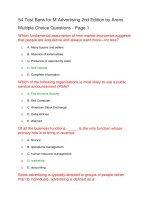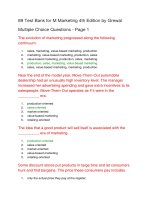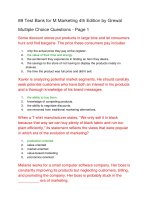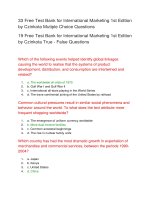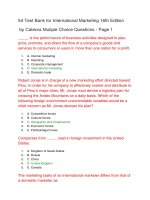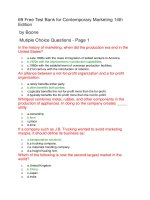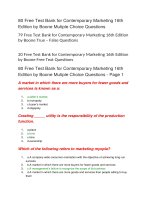54 test bank for international marketing 16th edition
Bạn đang xem bản rút gọn của tài liệu. Xem và tải ngay bản đầy đủ của tài liệu tại đây (93.24 KB, 19 trang )
54 Test Bank for International Marketing 16th Edition
by Cateora Mutiple Choice Questions - Page 1
_____ is the performance of business activities designed to plan,
price, promote, and direct the flow of a company’s goods and
services to consumers or users in more than one nation for a profit.
1.
A. Internal marketing
2.
B. Importing
3.
C. Corporate management
4.
D. International marketing
5.
E. Domestic trade
Robert Jonas is in charge of a new marketing effort directed toward
Peru. In order for his company to effectively market and distribute to
all of Peru’s major cities, Mr. Jonas must devise a logistics plan for
crossing the Andes Mountains on a daily basis. Which of the
following foreign environment uncontrollable variables would be a
chief concern as Mr. Jonas devises his plan?
1.
A. Competitive forces
2.
B. Cultural forces
3.
C. Geography and infrastructure
4.
D. Economic forces
5.
E. Political/legal forces
Companies from _____ lead in foreign investment in the United
States.
1.
A. Kingdom of Saudi Arabia
2.
B. Russia
3.
C. China
4.
D. United Kingdom
5.
E. Canada
The marketing tasks of an international marketer differs from that of
a domestic marketer as:
1.
A. the international marketer has fewer uncontrollable elements to deal with
compared to a domestic marketer.
2.
B. the level of technology and cultural forces are controllable elements for the
domestic marketer.
3.
C. the structure of distribution is an uncontrollable element for the
international marketer.
4.
D. the competitive structure is one of the controllable factors for an
international marketer.
5.
E. the international marketer is less concerned about geography and
infrastructure than the domestic marketer.
Which of the following elements in the marketing environment
poses a challenge to both domestic and international marketers due
to its uncontrollable nature?
1.
A. Price
2.
B. Promotion
3.
C. Research activities
4.
D. Political/legal forces
5.
E. Channels of distribution
_____ is a controllable element in both domestic and international
marketing environments.
1.
A. Economic climate
2.
B. Competition within the home country
3.
C. Price of products
4.
D. Political forces
5.
E. Foreign policies
Which of the following is an uncontrollable factor for a marketer in a
domestic environment?
1.
A. Firm characteristics
2.
B. Competitive structure
3.
C. Channels of distribution
4.
D. Price of the product
5.
E. Promotional measures
For an international marketer, the _____ can be altered in the long
run and, usually, in the short run to adjust to changing market
conditions, consumer tastes, or corporate objectives.
1.
A. competitive structure
2.
B. economic climate
3.
C. structure of distribution
4.
D. environmental factors
5.
E. controllable elements
_____ is an unconscious reference to one’s own cultural values,
experiences, and knowledge as a basis for decisions.
1.
A. Nativism
2.
B. Holism
3.
C. Self-reference criterion
4.
D. Segregation
5.
E. Xenophobia
Which of the following reflects the relationship between international
business and domestic business?
1.
A. Domestic businesses find it relatively easy to manage profits in the current
scenario.
2.
B. Domestic businesses find it relatively easy to manage profits in the current
scenario.
3.
C. Most domestic businesses are the result of customization efforts of
international businesses.
4.
D. The ability to invest abroad is to a large extent a function of domestic
economic vitality.
5.
E. Domestic businesses are more viable as capital tends to move toward
minimum use.
M&M, a company producing musical instruments, had dominated its
home market for several years before venturing into international
markets.It was focusing more on international operations until a
German company in the same business entered its home market.
The German company started selling good quality products at
prices much lower than M&M’s and affected its sales adversely.
Which of the following elements in the marketing environment has
affected the business of M&M in the above scenario?
1.
A. Level of technology
2.
B. Structure of distribution
3.
C. Competition in the domestic market
4.
D. Cultural forces
5.
E. Promotion of the product
Which of the following political actions is likely to favor international
marketing?
1.
A. Placing trade embargo on Cuba owing to widespread political instability in
the country.
2.
B. U.S. government placing a trade ban on Libya for rampant terrorism.
3.
C. Paraguay imposing low tariffs and tax rates for manufacturing industries.
4.
D. Tariff hike for imports established by China.
5.
E. U.S. government coupling human rights issues with foreign trade policy.
Which of the following best illustrates the political and legal issues
faced by companies because of their “alien status” when they
attempt to do business in foreign countries?
1.
A. A company doing moderate business in international markets because of
violent history of its home country.
2.
B. A company being forced by the local government to share its core
competencies in order to continue doing business.
3.
C. A product not being widely accepted in the foreign market because of its
irrelevance to the customers.
4.
D. A company utilizing an identical promotional campaign it used in the
domestic country.
5.
E. A company not succeeding in a foreign market because its product pricing
is above the purchasing power of the local customers.
Which of the following is a possible outcome of the “alien status” of
a company?
1.
A. An increase in protectionist federal policies.
2.
B. A positive balance of trade.
3.
C. A sharp rise in domestic and international demand.
4.
D. A huge trade deficit.
5.
E. An economic situation of the magnitude of the Great Depression.
With respect to the environment in which a business operates,
factors such as competition, political and legal forces, economic
climate, would all be classified as:
1.
A. controllable elements.
2.
B. uncontrollable elements.
3.
C. predictable elements.
4.
D. demographic elements.
5.
E. cultural elements.
Which of the following is true regarding the impact of globalization
on domestic markets in the United States?
1.
A. Companies with only domestic markets have been able to sustain their
customary rates of growth.
2.
B. Multinational companies are making more profits from their domestic
operations compared to their earnings from the foreign markets.
3.
C. Only multinational companies with large production facilities have
succeeded in the international markets.
4.
D. The domestic companies have reduced their manufacturing employment
more than the US multinationals.
5.
E. Multinational manufacturing companies in all industries and sizes have
outperformed their domestic counterparts.
In the United States, unrelated individuals keep a certain physical
distance between themselves and others when talking or in groups.
Americans do not consciously think about that distance; they just
know what feels right without thinking. Someone from another
culture would not necessarily understand this and would apply their
rules for contact when speaking. The preceding is an illustration of
what is called applying a _____ when reviewing the mentioned
social custom of contact.
1.
A. self-space principle
2.
B. segregation principle
3.
C. integration criterion
4.
D. space command criterion
5.
E. self-reference criterion
_____ is the conscious effort on the part of the international
marketer to anticipate the influences of both the foreign and
domestic uncontrollable factors on a marketing mix and then to
adjust the marketing mix to minimize the effects.
1.
A. Standardization
2.
B. Adaptation
3.
C. Segregation
4.
D. Segmentation
5.
E. Projection
The primary obstacles to success in international marketing are a
person’s _____ and an associated ethnocentrism.
1.
A. regionalism
2.
B. holism
3.
C. self-reference criterion
4.
D. effort at adaptation
5.
E. effort at integration
Which of the following is an uncontrollable element for an
international marketer?
1.
A. Firm characteristics
2.
B. Promotion
3.
C. Price
4.
D. Research
5.
E. Level of technology
Amy Sims has been assigned the task of preparing a marketing
plan for her company for the next year’s business activities. She
knows that she should begin her plan by examining the variables
that she has some control over. These controllable variables would
include price, product, channels-of-distribution, and _____.
1.
A. demand
2.
B. political forces
3.
C. competition
4.
D. economic climate
5.
E. promotion
Which of the following is an essential requirement for companies to
succeed in international markets?
1.
A. Binding strictly to their traditional methods of operations to succeed in
international markets.
2.
B. Focusing primarily on their production to meet the demands at home.
3.
C. Venturing into multiple markets at once.
4.
D. Committing themselves completely to foreign markets.
5.
E. Focusing on improving the domestic market to invest the returns in
international markets.
Which of the following is the most critical difference between
domestic marketing and international marketing?
1.
A. The difference in marketing principles being followed.
2.
B. The different concepts of marketing.
3.
C. The change in marketing goals.
4.
D. The environment in which marketing plans must be implemented.
5.
E. The basic processes used to market products and services.
Which of the following is a dynamic trend that is affecting the
current global business strategies?
1.
2.
A. The trend toward buying American cars in Europe.
B. The trend toward the acceptance of the free market system among
developing countries.
3.
C. The trend toward using English as the global language.
4.
D. The trend toward establishing a world currency.
5.
E. The trend toward worldwide instant communication.
The _____ issues faced by a company are often amplified by the
“alien status” of the company, which increases the difficulty of
properly assessing and forecasting the dynamic international
business climate.
1.
A. product research
2.
B. pricing
3.
C. product specification
4.
D. political/legal
5.
E. promotional
Compared to the foreign environment uncontrollable variables,
which of the following elements is excluded from the domestic
marketer’s list of uncontrollable variables?
1.
A. Political forces
2.
B. Competitive structure
3.
C. Economic climate
4.
D. Cultural forces
5.
E. Legal forces
Which of the following is a controllable element for an international
marketer?
1.
A. Level of technology
2.
B. Geography and infrastructure
3.
C. Channels of distribution
4.
D. Cultural forces
5.
E. Structure of distribution
54 Free Test Bank for International Marketing 16th
Edition by Cateora Mutiple Choice Questions - Page 2
Which of the following firms has a better chance of accelerating the
internationalization process?
1.
A. International regulatory bodies set export/import limits.
2.
B. The importing country can levy heavier import tariffs to override the VERs.
3.
C. The exporting country sets the limits on the quantity it will export.
4.
5.
D. It is a mandatory tax imposed by a government on goods entering at its
borders.
E. It is an absolute restriction against the importation of certain goods.
_____ impedes the ability of a person to assess a foreign market in
its true light.
1.
A. Nativism
2.
B. Pluralism
3.
C. Xenocentrism
4.
D. Ethnocentrism
5.
E. Relativism
Which of the following characterizes a globally aware manager?
1.
A. Using one’s home culture’s values alone to market one’s products in
foreign countries.
2.
B. Accepting the cultural ways of another individual as their own.
3.
C. Allowing others to be different and equal.
4.
D. Discarding one’s home culture’s standards to adopt the global cultural
standards.
5.
E. Controlling any influences that the global cultural standards may have on
the marketing process.
Which of the following will aid a manager in understanding the way
people of different countries think and act?
1.
A. A better understanding of global economic trends.
2.
B. A deeper understanding of world market potential.
3.
C. An understanding of foreign investment opportunities.
4.
D. An understanding of microeconomics.
5.
E. A historical perspective.
What is the most profound change for firms at the global marketing
stage of internationalization?
1.
A. Planning involves production of goods outside the home market.
2.
B. Sales to foreign markets are made as and when goods become available.
3.
C. Temporary surpluses marketed in foreign markets is the only element of
internationalization.
4.
D. Companies treat the world, along with home market, as one market.
5.
E. Production capacity exceeds domestic demand.
Understanding one’s own culture requires additional study as:
1.
A. self-criticism is not easy to build when studying one’s own culture.
2.
B. much of the cultural influence on market behavior is at the subconscious
level.
3.
C. the cultural traits in one’s own country are complex and not internalized.
4.
D. international trade treaties mandate that managers have extensive cultural
knowledge of their own country.
5.
E. cultural influence on one’s own market behavior is generally minimal and
insignificant in the long run.
To avoid errors in business decisions, it is necessary to conduct a
cross-cultural analysis that isolates the self-reference criterion
influences. Which of the following should be the first-step to avoid
the aforementioned errors?
1.
A. Redefining the problem without the SRC influence.
2.
B. Solving the problem for the optimum business goal situation.
3.
C. Isolating the SRC influence in the problem and examining it carefully to see
how it complicates the problem.
4.
D. Defining the business problem or goal in home-country cultural traits,
habits, or norms.
5.
E. Defining the business problem or goal in foreign-country cultural traits,
habits, or norms through consultation with natives of the target country.
Jefferson’s is a firm that specializes in dog food and grooming
products. The company has a very well-established domestic
market. The company does not actively sell its products outside
national borders but provides goods to customers who contact them
directly or place orders with them through the Internet. Jefferson’s is
currently in the _____ stage of international marketing involvement.
1.
A. frequent foreign marketing
2.
B. active foreign marketing
3.
C. global marketing
4.
D. regular foreign marketing
5.
E. no direct foreign marketing
Which of the following best describes the stage of development
where the company’s products reach a foreign market without any
conscious effort on the part of the marketer?
1.
A. Infrequent foreign marketing
2.
B. Regular foreign marketing
3.
C. No direct foreign marketing
4.
D. International marketing
5.
E. Global marketing
The firms at the stage of regular foreign marketing of international
marketing involvement:
1.
A. sell products that are a result of planned production in markets in various
countries.
2.
B. primarily focus all their operations and production to service domestic
market needs.
3.
C. have a global perspective and view the entire world as one market devoid
of any segments based on nationality.
4.
5.
D. have half their sales revenues coming from international markets.
E. have no intention of maintaining continuous market representation in
foreign markets.
Which of the following is true of firms at the international marketing
stage of marketing involvement?
1.
A. The primary focus of operations and production is to service domestic
market needs.
2.
B. As domestic demand increases and absorbs surpluses, foreign sales
activity is reduced or even withdrawn.
3.
C. Profit expectations from foreign markets are seen primarily as a bonus in
addition to regular domestic profits.
4.
D. Planning generally entails production of goods outside the home market.
5.
E. The firm treats the world, including the home market, as one market.
Which of the following is true regarding the stages of international
marketing involvement?
1.
A. A firm essentially progresses through the stages in a linear order.
2.
B. The international marketing stage represents the highest level of
international involvement.
3.
C. A firm begins its international involvement at the second stage.
4.
D. A firm may be in more than one stage simultaneously.
5.
E. The final stage of the process is involves no direct foreign marketing.
Which of the following is the most effective way to achieve
organizational global awareness?
1.
A. Hiring employees based on the sole criterion of global awareness.
2.
B. Organizing employee trips to foreign cultures to increase their sensitivity.
3.
C. Increasing the diversity mix of the front-level employee profile.
4.
D. Having a culturally diverse senior executive staff or board of directors.
5.
E. Promoting social networking as a means to improve inter-cultural
communication.
Regular foreign marketing stage differs from the international
marketing stage as companies at the regular foreign marketing
stage:
1.
2.
3.
A. fail to actively seek customers in international markets.
B. market their products in international markets only when there is a surplus
in production.
C. fail to represent careful strategic thinking about international expansion.
4.
D. lack permanent productive capacity that is devoted for production of goods
and services to be marketed in international markets.
5.
E. focus all their operations and production to service the domestic market
needs even though they are interested in foreign markets.
James Bright’s company seeks markets all over the world and
attempts to sell products that are a result of planned production for
markets in various countries. Which of the following stages best
characterizes the stage of international marketing involvement for
Mr. Bright’s company?
1.
A. Infrequent foreign marketing
2.
B. Regular foreign marketing
3.
C. No direct foreign marketing
4.
D. International marketing
5.
E. Internal marketing
Which of the following types of nontariff barriers strictly falls under
the category of specific limitations on trade?
1.
A. Import credit discriminations
2.
B. Export subsidies
3.
C. Voluntary export restraints
4.
D. Embargoes
5.
E. Packaging, labeling, or marking standards
Ajax Corporation has decided to enter the international marketing
arena by marketing its products on a country-by-country basis, with
separate marketing strategies for each country. The company is
using which of the following concepts to formulate its international
policies and strategies?
1.
A. Domestic market extension concept
2.
B. Multidomestic market concept
3.
C. Mass marketing concept
4.
D. Universal marketing concept
5.
E. Standardized marketing concept
For a company at the _____ stage of internationalization, market
segments are defined by income levels, usage patterns, or other
factors that frequently span countries and regions.
1.
A. domestic market extension
2.
B. no direct foreign marketing
3.
C. global marketing
4.
D. internal marketing
5.
E. infrequent foreign marketing
If a marketer is motivated to initiate an international marketing effort
mainly because of temporary surpluses in the domestic market,
which of the following stages best characterizes the stage of
international marketing involvement for this marketer?
1.
A. Infrequent foreign marketing
2.
B. Regular foreign marketing
3.
C. No direct foreign marketing
4.
D. International marketing
5.
E. Global marketing
The most effective way to control the influence of ethnocentrism
and the SRC is to:
1.
A. reduce interaction with culturally diverse audience.
2.
B. ask for feedback on every possible occasion.
3.
C. recognize their effects on our behavior.
4.
D. learn at least two foreign languages to understand the cultural differences.
5.
E. ask for second opinion in a decision-making scenario.
In which of the following stages of international marketing
involvement, companies primarily focus all their operations and
production to service domestic market needs, even though they
have a permanent productive capacity devoted to the production of
goods to be marketed in foreign markets?
1.
A. No direct foreign marketing
2.
B. Infrequent foreign marketing
3.
C. Regular foreign marketing
4.
D. International marketing
5.
E. Global marketing
Which of the following is true of ethnocentrism?
1.
A. It is the cultural binding force among a diverse employee population in an
organization.
2.
B. It is a problem that arises when managers from affluent countries work with
managers and markets in less affluent countries.
3.
C. American managers have generally been uninfluenced by it, especially in
the beginning of the 21st century.
4.
D. It is the cornerstone of effective adaptation in the field of international
marketing.
5.
E. Self-reference criterion is universally considered the technique to reduce or
eliminate ethnocentrism.
Which of the following firms/products reflects a global marketing
orientation?
1.
A. A skin-lightening cream aimed at African American women.
2.
B. A company promoting Latino jazz musicals.
3.
C. A firm producing highly cost-effective and durable computers.
4.
D. A famous restaurant in Singapore that specializes in Oriental food.
5.
E. A Japanese to English translation software.
Which of the following is true of firms in the first two stages of
international marketing involvement—no direct foreign marketing
and infrequent foreign marketing?
1.
A. They do not begin internationalization at these stages.
2.
B. They take a strategic approach to decision making regarding international
expansion.
3.
C. They are more reactive in nature and embark on internationalization
without planning.
4.
D. They intend to maintain a continuous market representation in foreign
markets.
5.
E. They are a result of dedicated production capacity maintained for foreign
markets.
Maria Peron’s company treats the world, including the home market
in Spain, as one market. Market segmentation decisions no longer
focus on national borders. Instead, market segments are defined by
income levels, usage patterns, and other factors that span countries
and regions. Which of the following stages best characterizes the
stage of international marketing involvement for Ms. Peron’s
company?
1.
A. Infrequent foreign marketing
2.
B. Test marketing
3.
C. No direct foreign marketing
4.
D. Internal marketing
5.
E. Global marketing
Which of the following organizations seems better equipped for
internationalization?
1.
A. A firm that sells its products only to those foreign customers who directly
contact the firm.
2.
B. A firm that has a production capacity that is much greater than home
market demand.
3.
C. A firm that focuses its production activities on meeting the demands in the
home market.
4.
D. A firm that has a culturally diverse employee profile but few competitive
offerings at the global level.
5.
E. A firm that has little intention of maintaining a continuous market
representation.
Which of the following is closely related to the self-reference
criterion?
1.
A. Differentiation
2.
B. Marketing myopia
3.
C. Ethnocentrism
4.
D. Multiculturalism
5.
E. Pluralism
